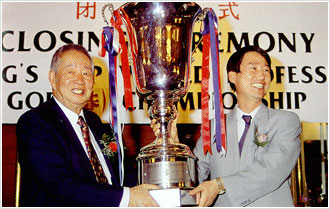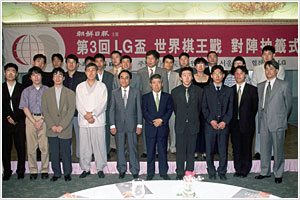The Golden Age of Korean Baduk

After the rise in standard of Korean Baduk, as described previously, the top Korean professional players started to find success internationally. The first major achievement was in September 1989 when Cho Hun-hyun became the champion in the first running of the Ing-s cup tournament (Baduk Olympiad), which takes place every four years, beating the Chinese number one Nie Weiping in the final.
After Cho Hun-hyun' s success and consequent popularization of Baduk in Korea, there was an explosion of interest from the general public, which
was further fueled by the successful debut of Lee Chang-ho. At this time Korean players won eight consecutive international tournaments, and as a result of these and many other successes, Korea was recognized as the world number one. In the mid 90'S Lee Chang-ho achieved a level of domestic hegemony that left the other top and rising players trailing in his wake.
Much of the international dominance was achievedsolely by the group of four top players (Seo Bong-su, Cho Hun-hyun, Yu Chang-hyuk and Lee Chang-ho).
Achievements of Korean Baduk
In 1989 Lee Chang-ho made his successful national debut, winning the 8th KBS Baduk Wang (King of Baduk) title, becoming the youngest player to ever win at this level. This signaled the beginning of the 'Four Players Period' . In 1991 Lee Chang-ho won the 3rd Tong yang Securities Cup, his first international victory, as the youngest player to achieve this feat.
In 1994 Lee Chang-ho completed his set of the 16 domestic titles, so establishing his dominance over the other top players. Lee continued to rewrite the record books despite resistance from Cho Hun-hyun. His statistical triumphs include playing 111 games in 1989, winning 41 consecutive games in 1990, winning 90 games in 1993 and winning thirteen titles in 1994, amongst others.
Korean international achievements include in 1993 winning the first Jinro Cup World Baduk Team Tournament. Individual achievements included Seo Bong-su's 2nd Ing Cup Baduk Olympiad victory, Lee Chang-ho's 4th Tong yang Securities Cup, and Yu Chang-hyuk's 6th Fujitsu Cup, which completed a clean sweep of international titles. In 1994 honors included the 2nd Jinro Cup, Cho Hun-hyun's 5th Tong yang Securities Cup and 7th Fujitsu Cup, which completed his grand slam of the international tournaments and made him the first player to achieve this distinction. In 1995 Korea won the 3rd Jinro Cup, which completed eight consecutive international tournaments. During this perood Korea achieved its dominant position over China and Japan.
Korea as World Leader in Baduk

1996 was an important year in establishing Korea as the world number one. In this year the LG and Samsung industrial groups began their sponsorships of major international tournaments, the Samsung Fire Cup (an open tournament) and the LG Cup. Henceforth the top players spent more time touring and playing at international level. Also in this year Yu Chang-hyuk won the 3rd Ing Cup, which was Korea's third consecutive victory. The most significant achievement in this year was Lee Chang-ho's garnering of four international titles, to become the world's number one player. At the beginning of 1997, Korea won their fifth consecutive Jinro Cup thanks l " Seo Bong-su's nine straight victories over the top Japanese and Chinese representatives.
Lee Chang-ho Emerges as the World Number One.
In the 97/98 season, Lee Chang-ho consolidated his position as the world champion. Domestically he swept the opposition away, winning almost all the titles, and was equally successful internationally, winning the 1st LG Cup, the 2nd Samsung Cup, the 9th Tong yang Securities Cup and the 3rd Samsung Cup. Players over the world aspire to Lee Chang-ho' s prowess, but expect his dominance to continue for the time being. The future for Korean Baduk looks very bright with many brilliant youth players who are still developing their talents.
After the 1998 Asian Financial Crisis, activities became severely constricted. Now, however, the situation looks much brighter and poised for another take off. The Internet Baduk boom will playa large part in this. The KBA leads in Internet Baduk with live game commentaries, significant game appreciations, many technical essays and so on provided through the 'World Cyber Kiwon¡¯. The rapid development of Internet Baduk makes advanced information and theory available to a wide audience.
At the beginning of year 2000 the Korean professional players continued to dominate, with Lee Chang-ho' s third consecutive Samsung Cup, Cho Hun-hyun's Fujitsu Cup win which follows Yu Chang- hyuk's win of 1999, Korea's Nongsim Cup team victory and Hungchang Cup (Women's International title) victory.


